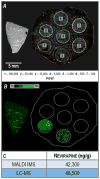MALDI imaging mass spectrometry: spatial molecular analysis to enable a new age of discovery
- PMID: 24686089
- PMCID: PMC4104210
- DOI: 10.1016/j.jprot.2014.03.021
MALDI imaging mass spectrometry: spatial molecular analysis to enable a new age of discovery
Abstract
Matrix-assisted laser desorption/ionization imaging mass spectrometry (MALDI IMS) combines the sensitivity and selectivity of mass spectrometry with spatial analysis to provide a new dimension for histological analyses to provide unbiased visualization of the arrangement of biomolecules in tissue. As such, MALDI IMS has the capability to become a powerful new molecular technology for the biological and clinical sciences. In this review, we briefly describe several applications of MALDI IMS covering a range of molecular weights, from drugs to proteins. Current limitations and challenges are discussed along with recent developments to address these issues. This article is part of a Special Issue entitled: 20years of Proteomics in memory of Viatliano Pallini. Guest Editors: Luca Bini, Juan J. Calvete, Natacha Turck, Denis Hochstrasser and Jean-Charles Sanchez.
Keywords: MALDI imaging mass spectrometry.
Copyright © 2014 Elsevier B.V. All rights reserved.
Conflict of interest statement
Conflict of Interest
The authors declare no conflict of interest.
Figures







Similar articles
-
Laying the groundwork for proteomics: mass spectrometry from 1958 to 1988.J Proteomics. 2014 Jul 31;107:62-70. doi: 10.1016/j.jprot.2014.01.008. Epub 2014 Jan 18. J Proteomics. 2014. PMID: 24448399 Review.
-
Six decades searching for meaning in the proteome.J Proteomics. 2014 Jul 31;107:24-30. doi: 10.1016/j.jprot.2014.03.005. Epub 2014 Mar 16. J Proteomics. 2014. PMID: 24642211 Review.
-
A personal account of the early stages of proteomics at Aarhus University.J Proteomics. 2014 Jul 31;107:31-8. doi: 10.1016/j.jprot.2014.01.021. Epub 2014 Jan 25. J Proteomics. 2014. PMID: 24473278
-
Twenty years of protein interaction studies for biological function deciphering.J Proteomics. 2014 Jul 31;107:93-7. doi: 10.1016/j.jprot.2014.03.038. Epub 2014 Apr 4. J Proteomics. 2014. PMID: 24709640 Review.
-
A Sydney proteome story.J Proteomics. 2014 Jul 31;107:13-23. doi: 10.1016/j.jprot.2014.04.006. Epub 2014 Apr 13. J Proteomics. 2014. PMID: 24735915 Review.
Cited by
-
Unravelling Prostate Cancer Heterogeneity Using Spatial Approaches to Lipidomics and Transcriptomics.Cancers (Basel). 2022 Mar 27;14(7):1702. doi: 10.3390/cancers14071702. Cancers (Basel). 2022. PMID: 35406474 Free PMC article. Review.
-
CCL5-CCR5 interactions modulate metabolic events during tumor onset to promote tumorigenesis.BMC Cancer. 2017 Dec 8;17(1):834. doi: 10.1186/s12885-017-3817-0. BMC Cancer. 2017. PMID: 29216863 Free PMC article.
-
Shotgun lipidomics and mass spectrometry imaging unveil diversity and dynamics in Gammarus fossarum lipid composition.iScience. 2021 Jan 29;24(2):102115. doi: 10.1016/j.isci.2021.102115. eCollection 2021 Feb 19. iScience. 2021. PMID: 33615205 Free PMC article.
-
Matrix-Assisted Laser Desorption Ionization Mapping of Lysophosphatidic Acid Changes after Traumatic Brain Injury and the Relationship to Cellular Pathology.Am J Pathol. 2018 Aug;188(8):1779-1793. doi: 10.1016/j.ajpath.2018.05.005. Epub 2018 Jul 16. Am J Pathol. 2018. PMID: 30037420 Free PMC article.
-
Mass Spectrometry Imaging and GC-MS Profiling of the Mammalian Peripheral Sensory-Motor Circuit.J Am Soc Mass Spectrom. 2015 Jun;26(6):958-66. doi: 10.1007/s13361-015-1128-8. Epub 2015 Mar 31. J Am Soc Mass Spectrom. 2015. PMID: 25822927 Free PMC article.
References
-
- de Godoy LMF, Olsen JV, Cox J, Nielsen ML, Hubner NC, Froehlich F, et al. Comprehensive mass-spectrometry-based proteome quantification of haploid versus diploid yeast. Nature. 2008;455:1251–U60. - PubMed
-
- Caprioli RM, Farmer TB, Gile J. Molecular imaging of biological samples: Localization of peptides and proteins using MALDI-TOF MS. Analytical Chemistry. 1997;69:4751–60. - PubMed
-
- Stoeckli M, Chaurand P, Hallahan DE, Caprioli RM. Imaging mass spectrometry: A new technology for the analysis of protein expression in mammalian tissues. Nature Medicine. 2001;7:493–6. - PubMed
Publication types
MeSH terms
Substances
Grants and funding
LinkOut - more resources
Full Text Sources
Other Literature Sources
Research Materials

